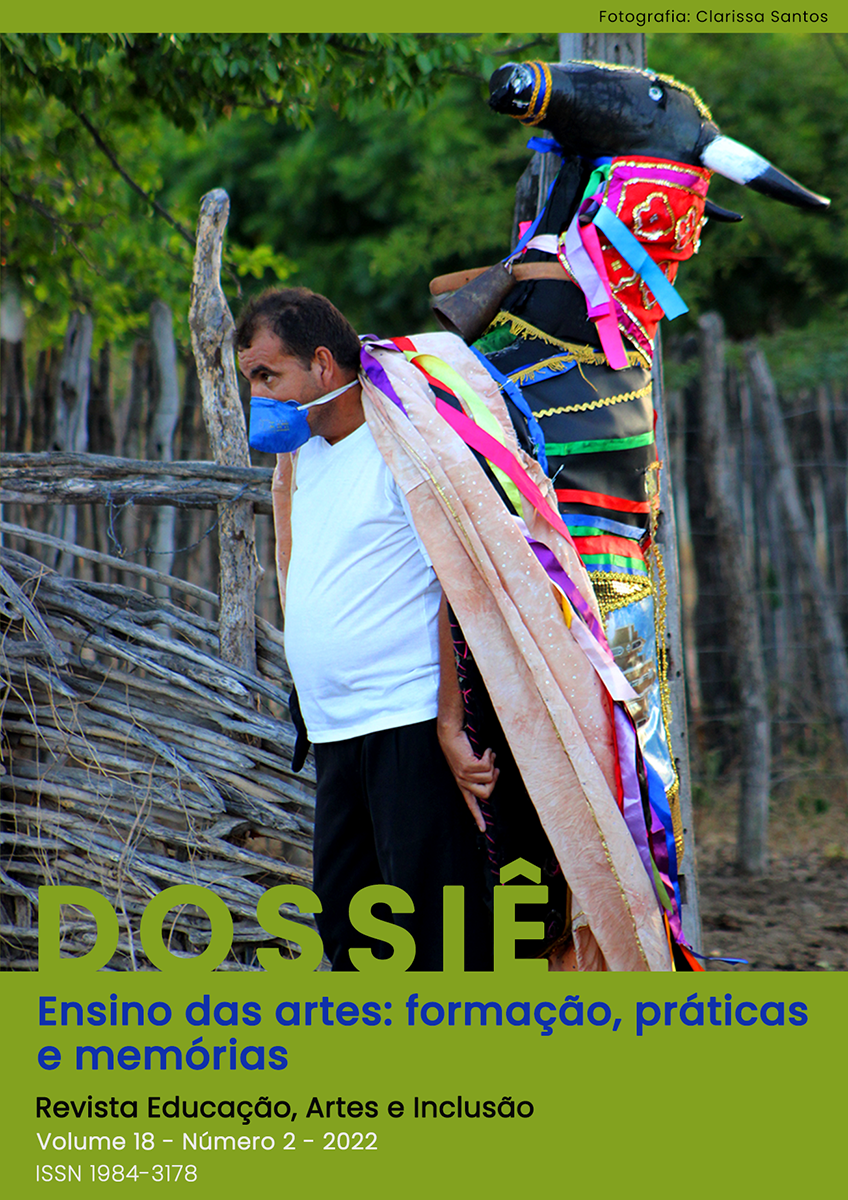Descolonizando saberes em dança: a formação técnica profissionalizante do colégio Luís Eduardo Magalhães de Itabuna, Bahia, em diálogo com Paulo Freire
DOI:
https://doi.org/10.5965/19843178182202278Palavras-chave:
Currículo, Emancipação, Pensamento descolonialResumo
O presente trabalho propõe uma análise do currículo do Curso Técnico Profissionalizante em Dança do Colégio Modelo Luís Eduardo Magalhães de Itabuna, Bahia, baseada nas teorias críticas e no ideário emancipatório de Paulo Freire, a fim de identificar a existência de conteúdos eleitos segundo os mecanismos de dominação advindos da colonialidade. Além disso, a pesquisa alerta para a urgência de construção de práticas que descolonizem o currículo para uma formação técnica profissionalizante em Dança pautada no respeito à diversidade cultural. A pesquisa quanto a sua abordagem, é qualitativa; quanto a sua natureza, básica; quanto aos objetivos, exploratória; e quanto aos procedimentos, bibliográfica. Para realizar a pesquisa, foram analisadas recentes teorias das ciências que versam sobre Educação (FREIRE, 1967; 1987; 1989; 1996), Dança (SANTOS, 2009) (SETENTA, 2017), Biopolítica (FOUCAULT, 1987; 1988; 1999) (AGAMBEN, 2009), Currículo (RANGHETTI; GESSER, 2009) (SILVA; 2010) e pensamento descolonial (COSTA; 2006) (GOMES, 2012) (KILOMBA, 2019) (MBEMBE, 2016). Concluiu-se que o currículo referido não foi elaborado a partir de uma construção participativa, colaborativa, e que sua lógica ainda é eurocêntrica.
Downloads
Referências
AGAMBEN, Giorgio. O que é contemporâneo e outros ensaios. Chapecó, SC: Argos, 2009.
ARDILA OSORIO, Gina Paola. Possibilidades e limites da dança para o empoderamento das mulheres: Um olhar da saúde coletiva. 2015. 128 f., il. Dissertação (Mestrado em Ciências) – Universidade de São Paulo (USP), 2015.
BAHIA. Plano de Curso - Técnico em Dança. Colégio Modelo Luís Eduardo Magalhães / Itabuna – BA. Secretaria de Educação do Estado da Bahia, 2018.
BALLESTRIN, Luciana. América Latina e o giro decolonial. Revista Brasileira de Ciência Política, nº11. Brasília, maio - agosto de 2013.
BRASIL. Catálogo Nacional de Cursos Técnicos. Ministério da Educação, 2016.
COSTA, Sergio. Dois Atlânticos: teoria social, anti-racismo e cosmopolitismo. Belo Horizonte: Editora UFMG, 2006.
FOUCAULT, Michel. Vigiar e punir: nascimento da prisão. Trad. Raquel Ramalhete. 20ªedição. Petrópolis: Vozes, 1987.
______. História da sexualidade – A vontade de saber. Trad. Maria Thereza da Costa Albuquerque e J. A. Guilhon Albuquerque. 13ª ed. Rio de Janeiro: Graal, 1988.
______. Em defesa da sociedade: curso no Collége de France (1975-1976). Trad. Maria Emantina Galvão. São Paulo: Martins Fontes, 1999.
FREIRE, P. Educação como prática da liberdade. Rio de Janeiro: Paz e Terra, 1967.
______. Pedagogia do Oprimido. Rio de Janeiro: Paz e Terra, 1987.
______. A importância do ato de ler: em três artigos que se completam. São Paulo: Cortez, 1989.
______. Pedagogia da autonomia: saberes necessários à prática educativa. 25ª Edição São Paulo: Paz e Terra, 1996.
GOMES, Nilma Lino. Relações étnico-raciais, educação e descolonização dos currículos. Currículo sem Fronteiras, v.12, n.1, pp. 98-109, Jan/Abr 2012.
GONÇALVES, Camila Correia Santos. Dança no ambiente escolar – por um conhecimento com ações emancipatórias. 2017. 102 f. Dissertação (Mestrado -Programa de pós-graduação em Dança) -Universidade Federal da Bahia, Escola de Dança, 2017.
KEALIINOHOMOKU, Joann. Uma antropóloga olha o Ballet Clássico como uma forma de dança étnica. In: CAMARGO, Giselle Guilhon Antunes (org.). Antropologia da Dança I. Florianópolis: Insular, 2013.
KILOMBA, Grada. Memórias da Plantação: episódios de racismo cotidiano. Trad. Jess Oliveira. 1ª. Ed. Rio De Janeiro: Cobogó, 2019.
MBEMBE, Achille. Necropolítica. In: BARTHOLOMEU, Cezar, TAVORA, Maria Luisa (Org.). Arte & Ensaios, n. 32. Rio de Janeiro: Programa de Pós-Graduação em Artes Visuais/ Escola de Belas Artes, UFRJ, 2016.
MORANDI, Carla. Entre a arte e a docência: a formação do artista da dança. Campinas: Papirus, 2006.
NOGUEIRA, Isabelle Cordeiro. Referenciais Históricos da Arte e da Dança. Salvador: UFBA, Escola de Dança, Superintendência de Educação a Distância, 2017.
PORFÍRIO, Francisco. Diferença entre ética e moral; Brasil Escola. Disponível em: https://brasilescola.uol.com.br/filosofia/diferenca-entre-etica-moral.htm. Acesso em 20 de janeiro de 2021.
RANGHETTI, D. S.; GESSER V. Estruturas Curriculares – Inter e Transdiciplinariedade. Indaial: Grupo Uniasselvi, 2009.
SANTOS, Inaicyra Falcão dos. Dança e Pluralidade Cultural: Corpo e Ancestralidade. Revista Múltiplas Leituras, v.2, n. 1, p. 31-38, jan. / jun. São Paulo: Universidade Metodista de São Paulo, 2009.
SETENTA, Jussara Sobreira. Referências Múltiplas da Dança. Salvador: UFBA, Escola de Dança; Superintendência de Educação a Distância, 2017.
SILVA, T. T. da. Documentos de identidade: uma introdução às teorias do currículo. Belo Horizonte: Autêntica, 2010.
Downloads
Publicado
Como Citar
Edição
Seção
Licença
Copyright (c) 2022 Thais Coelho e Sousa, Tássio Ferreira Santana

Este trabalho está licenciado sob uma licença Creative Commons Attribution-NonCommercial-ShareAlike 4.0 International License.
A Revista Educação Artes e Inclusão é um periódico que segue a Política de Acesso Livre. Os artigos publicados pela revista são de uso gratuito, destinados a aplicações educacionais e não comerciais. Os artigos cujos autores são identificados representam a expressão do ponto de vista de seus autores e não a posição oficial da Revista Educação, Artes e Inclusão [REAI].
Autores que publicam nesta revista concordam com os seguintes termos:
(a) Autores mantém os direitos autorais e concedem à revista o direito de primeira publicação, com o trabalho simultaneamente licenciado sob a Licença Creative Commons Attribution que permite o compartilhamento do trabalho com reconhecimento da autoria e publicação inicial nesta revista.
(b) Autores têm autorização para assumir contratos adicionais separadamente, para distribuição não-exclusiva da versão do trabalho publicada nesta revista (ex.: publicar em repositório institucional ou como capítulo de livro), com reconhecimento de autoria e publicação inicial nesta revista.
(c) Esta revista proporciona acesso público a todo o seu conteúdo, uma vez que isso permite uma maior visibilidade e alcance dos artigos e resenhas publicados. Para maiores informações sobre esta abordagem, visite Public Knowledge Project.
Esta revista está licenciada com uma Licença Creative Commons Atribuição-NãoComercial 4.0 Internacional. Esta licença permite que outros remixem, adaptem e criem a partir do seu trabalho para fins não comerciais, e embora os novos trabalhos tenham de lhe atribuir o devido crédito e não possam ser usados para fins comerciais, os usuários não têm de licenciar esses trabalhos derivados sob os mesmos termos.





